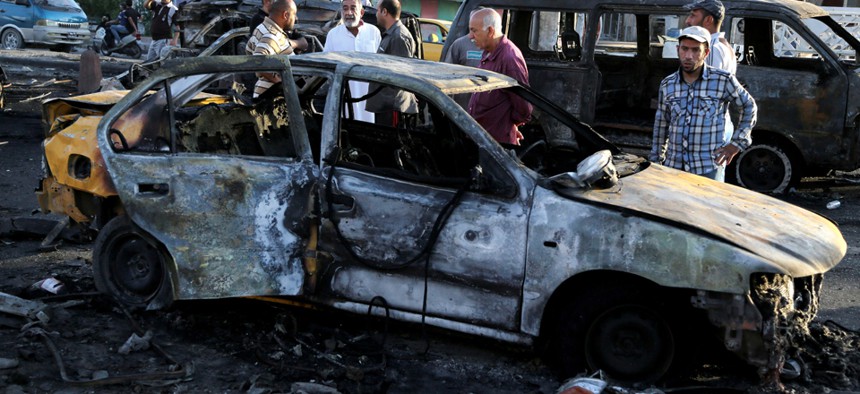
Iraqi civilians gather the morning after a string of car bombs tore through Baghdad last week. Karim Kadim/AP
ISIL Has Been Bombing Baghdad for Years
The U.S. threatens airstrikes in Baghdad if the militant group endangers personnel, but such attacks in and around the capital aren’t anything new.
Administration officials have said repeatedly that the United States will launch airstrikes if ISIL advances on Baghdad, but the Sunni militant group has carried out attacks in and around the capital for years.
The Islamic State in Iraq and Syria estimates that it carried out 641 total operations in Baghdad in 2013, up from 371 operations in 2012—ranging from car bombs to armed assault to assassinations, according to the Institute for the Study of War, a Washington-based think tank.
And ISIL shows no signs of stopping. At least five car bombs rocked Baghdad last week, largely in Shiite neighborhoods, leaving dozens of people dead.
The United States began moving some of its embassy staff from Baghdad in mid-June, but there are still more than 700 soldiers in Iraq—more than half of whom are dedicated to embassy security in the capital city.
Meanwhile, the United States launched a series of airstrikes in the past week against ISIL near Erbil in northern Iraq, as well as dropped humanitarian aid to the Yazidis, a stranded religious minority group. Al-Monitor's Laura Rozen asked State Department spokeswoman Marie Harf last week why strikes were being taken to protect U.S. personnel in Erbil when there have been ISIL bombings for years in Baghdad, including those "that are within hearing and feeling range of the U.S. Embassy." Harf acknowledged that there have been bombings in Baghdad, "but obviously we look at the threat and we look at the picture."
What an escalation of ISIL attacks in and around Baghdad would look like is unclear.
"The thing that we're looking for in Baghdad now really has to be scaled in the fact that ISIS brought its [vehicle borne explosive device] wave campaign to Baghdad in a decidedly concentrated way in February 2013," said Jessica Lewis, research director for the Institute for the Study of War. Lewis spent nearly three years with the Army in Iraq and Afghanistan providing intelligence support.
The widely accepted line of thinking is that ISIL would have a hard time taking Baghdad. Unlike the areas where the terrorist group has control, the capital is dominated by Shiites and Shiite militias, and it has a high number of Iraq's security forces.
"There's not a lot that they can use as a foothold," said Steven Simon, a senior fellow at the Middle East Institute, a nonpartisan think tank in Washington. But Simon, who served as the senior director for Middle Middle Eastern and North African affairs in the Obama White House during 2011 and 2012, added that "doesn't mean that they can't wreck and wreak havoc."
And American airstrikes, while useful for hitting precise targets like ISIL artillery, are virtually useless against a suicide or car bomb—the militant group's main mode of attack so far in the capital.
But even if the militant group doesn't capture Baghdad, it could still threaten the capital—and by extension U.S. military personnel—through the Mosul dam. Located in northern Iraq, ISIL and Kurdish forces have been battling over Iraq's largest dam, with the militant group reportedly taking control of the dam last week.
If ISIL decided to break the dam, it would "result in flooding along the Tigris River all the way to Baghdad," according to a 2007 letter from David Petraeus and Ryan Crocker, at the time the U.S. ambassador to Iraq.
Despite the many questions on what ISIL will do next, one thing is very certain: It could make life for the residents of Baghdad much, much worse than it already has.
Lewis said, "My concern for Baghdad is largely framed out of an expectation that we have not seen [ISIL] maximally engaged yet."







